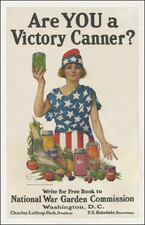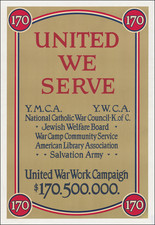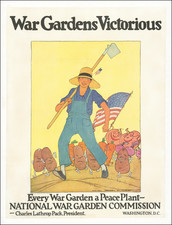Maginel Wright Enright's 1919 poster, War Gardens Over The Top, was commissioned by the National War Garden Commission, an organization dedicated to promoting the cultivation of "war gardens" or "victory gardens" during World War I. Charles Lathrop Pack, a leading figure in the forestry industry and the Commission's President, was a significant advocate for these gardens, as they helped to alleviate food shortages and bolster morale on the home front.
The poster presents a lively scene, featuring a young boy with a hoe and straw hat energetically leading an assortment of anthropomorphic vegetables down a hill, presumably from a "trench". The vegetables, including a patriotic pumpkin carrying the American flag, are all portrayed as if in the midst of a vigorous yell or cheer. This cheerful imagery, combined with the wartime language of the poster's text, embodies the optimistic spirit of the victory garden movement.
The phrases "War Gardens Over The Top" and "The Seeds of Victory Insure the Fruits of Peace" evoke the military language of the era, drawing a parallel between the cultivation of gardens at home and the battlefield efforts of soldiers abroad. The term "over the top," in particular, is a reference to soldiers charging out of their trenches during battle. However, as the poster was created during the war, the true horrors of these trench warfare charges were likely not fully understood by the general public, who largely depended on sanitized news articles and propagandized newsreels for their information.
Enright's use of anthropomorphic vegetables and a child protagonist makes the poster appealing and accessible, particularly to children and families. It communicates the message that everyone, regardless of age or ability, can contribute to the war effort simply by planting and tending to a garden. This strategy helped to democratize the war effort, fostering a sense of communal responsibility and shared sacrifice.
Overall, Enright's "War Gardens Over The Top" is more than just a charming piece of wartime propaganda. It provides insight into the home front activities during World War I, illustrating the collective efforts made by civilians to support the war effort and the strategic use of propaganda to motivate and unite the public.












![[WWI -- Poster] The Greatest Mother in the World](https://storage.googleapis.com/raremaps/img/small/77109.jpg)
![(First World War - German Propaganda) Die Eisenbahn, der Lebensnerv des Heeres. [The railway, the lifeblood of the army.]](https://storage.googleapis.com/raremaps/img/small/89362.jpg)
